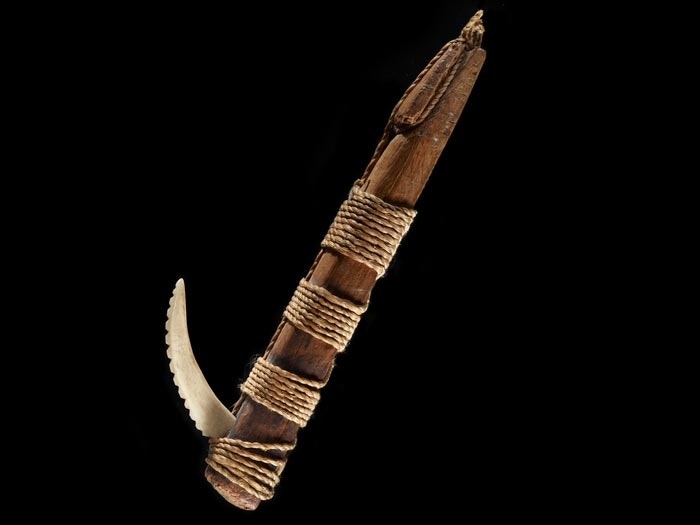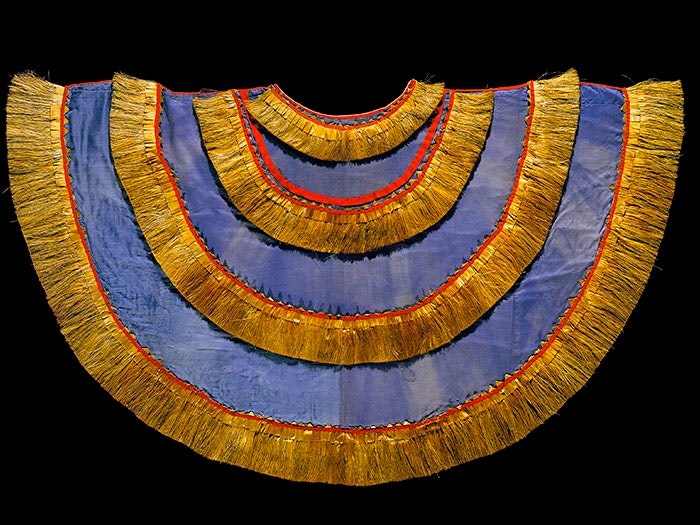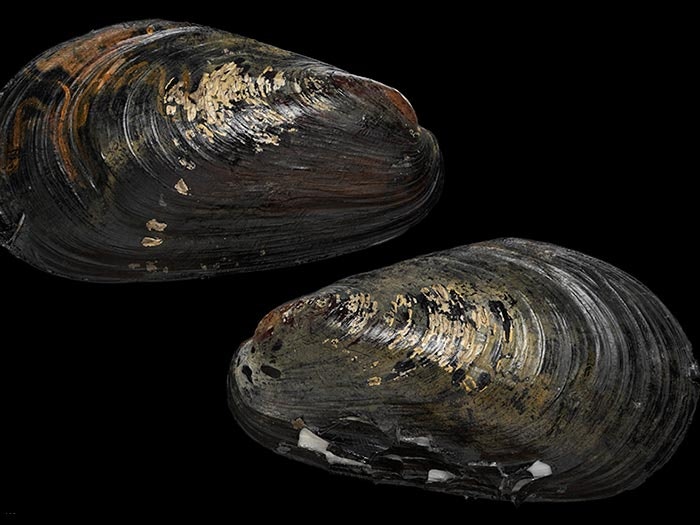
Tuhinga 21, 2010
Letter Man: representing graphic designer Joseph Churchward examines the work of Samoan-born graphic designer Joseph Churchward, who hand-created 750 typefaces.
Go to Letter Man: representing graphic designer Joseph Churchward
Māori fishhooks in European museums examines collections of Māori fish-hooks in European museums. Many found in these collections are in fact replicas and fakes produced for trade or to satisfy the demands of curio collectors.
Go to Māori fishhooks in European museums
Representing community exhibitions at the Museum of New Zealand Te Papa Tongarewa examines two case studies of community-focused exhibitions and the issues they pose for museums, including consultation and authenticity.
Go to Representing community exhibitions at the Museum of New Zealand Te Papa Tongarewa
A new genus and species of large mussel (Mollusca: Bivalvia: Mytilidae) from the Kermadec Ridge describes a new genus and species of large mussel discovered at active venting sites off the Kermadec Islands.
Go to A new genus and species of large mussel (Mollusca: Bivalvia: Mytilidae) from the Kermadec Ridge
Changes in the terrestrial molluscan fauna of Miti‘āro, southern Cook Islands explains how thirty-seven species of terrestrial molluscs found on a low-lying makatea island in the southern Cook Islands have changed over several hundred years.
Go to Changes in the terrestrial molluscan fauna of Miti‘āro, southern Cook Islands
Rediscovering the collection: Cook Islands material culture in the Museum of New Zealand Te Papa Tongarewa provides a critical overview of the development of Te Papa’s Cook Islands collection since 1865.
Go to Rediscovering the collection: Cook Islands material culture in the Museum of New Zealand Te Papa Tongarewa
Lifting the cloak of silence: redramatising clothing as material culture, through an object analysis of Te Aia’s cloak examines a strategy for understanding the 19th century blue woollen cloak of Rarotongan chief Te Aia, an object that lacks historical information to tell its story.
Go to Lifting the cloak of silence: redramatising clothing as material culture, through an object analysis of Te Aia’s cloak
The species of MyrsideaWaterston (Insecta: Phthiraptera: Menoponidae) from the Galápagos Islands, with descriptions of new taxa examines lice in the genus Myrsidea found on birds in the Galapagos Islands, and identifies several new taxa.
Go to The species of MyrsideaWaterston (Insecta: Phthiraptera: Menoponidae) from the Galápagos Islands, with descriptions of new taxa
A review of ectoparasites of Apteryx spp. (kiwi) in New Zealand, with new host records, and the biology of Ixodes anatis (Acari: Ixodidae) reviews both published and unpublished research into the diverse ectoparasites carried by the New Zealand kiwi, some of which present real risks to this threatened species.
Go to A review of ectoparasites of Apteryx spp. (kiwi) in New Zealand, with new host records, and the biology of Ixodes anatis (Acari: Ixodidae)
Coastal landsnail fauna of Rarotonga, Cook Islands: systematics, diversity, biogeography, faunal history, and environmental influences describes Rarotonga’s coastal landsnail fauna. While indigenous and endemic species were once abundant, many have declined or become extinct since the mid-19th century – largely due to habitat loss and introduced predators.
Go to Coastal landsnail fauna of Rarotonga, Cook Islands: systematics, diversity, biogeography, faunal history, and environmental influences
Letter Man: representing graphic designer Joseph Churchward
Safua Akeli
ABSTRACT: Since the 1960s, Samoan-born graphic designer Joseph Churchward has hand-created over 570 typefaces (fonts), the greatest number designed by any individual in the world. In 2008, the Museum of New Zealand Te Papa Tongarewa (Te Papa) acquired a large number of samples of Churchward’s work and showcased a range of pieces in the exhibition Letter Man: Joseph Churchward’s world of type. This new acquisition and exhibition deviated from the historical practice of collecting and exhibiting artefacts from the Pacific Islands, which previously had an ethnographic focus. This paper considers the rationale for acquiring an extensive archive of this nature for the Pacific Cultures collection.
Letter Man: representing graphic designer Joseph Churchward (741.55 KB)
Māori fishhooks in European museums
Chris D. Paulin
ABSTRACT: Māori and other Polynesian fishhooks held in museums throughout Europe were examined from collections in Russia, France, Austria, Ireland, Scotland and England. Among the hundreds of Māori hooks available, less than two dozen can reliably be attributed to the voyages of James Cook and other early European explorers, while many others are possibly of Cook origin but cannot be verified. Most museum collections include hooks made in the period between the 1880s and 1920s, when demand from ‘curio’ collectors led to many replicas or fakes being produced for trade purposes. These Māori fishhooks are vital to our understanding of how traditional Māori hooks were manufactured and functioned.
Māori fishhooks in European museums (674.76 KB)
Representing community exhibitions at the Museum of New Zealand Te Papa Tongarewa
Stephanie Gibson and Sean Mallon
ABSTRACT: Exhibitions at the Museum of New Zealand Te Papa Tongarewa (Te Papa) are represented and promoted through a title and ‘hero’ image. Te Papa works with external community advisors to determine titles and images for community-focused exhibitions. The authors analyse two exhibition case studies in terms of community consultation, the representation of complex communities, and authenticity of the images used: The Scots in New Zealand and Tangata o le Moana: the story of Pacific people in New Zealand.
Representing community exhibitions at the Museum of New Zealand Te Papa Tongarewa (884.92 KB)
A new genus and species of large mussel (Mollusca: Bivalvia: Mytilidae) from the Kermadec Ridge
Rudo von Cosel and Bruce A. Marshall
ABSTRACT: A large mussel, Vulcanidas insolatus new genus and new species, is described from active venting sites on Macauley and Giggenbach submarine volcanoes off Macauley Island, Kermadec Islands, northeast of New Zealand’s North Island. Based on morphology, the phylogenetically basal position of the new species to other large mussels from hot vents and cold seeps is confirmed: Vulcanidas n.gen. is closer to small mussels associated with sunken wood and whale falls (Modiolinae, genera Idas Jeffreys, 1876, dipicola
Dautzenberg, 1927 and BenthomodiolusDell, 1987). The new mussel has enlarged gills that support endosymbiotic sulphur-oxidising bacteria, a longer digestive tract than in other mussels from vents and seeps, and, uniquely, dendritically textured gonadal tissue on the inner mantle lobes. Vulcanidas insolatus lives in dense beds as shallow as 140 m, and is the shallowest-living vent or seep mussel.
A new genus and species of large mussel (Mollusca: Bivalvia: Mytilidae) from the Kermadec Ridge (1.26 MB)
Changes in the terrestrial molluscan fauna of Miti‘āro, southern Cook Islands
Fred J. Brook, Richard K. Walter and Jacqueline A. Craig
ABSTRACT: Thirty-seven species of terrestrial molluscs (36 landsnails and one slug) are recorded from Miti‘āro, a low-lying makatea island in the southern Cook Islands. The fauna was found to consist predominantly of non-indigenous and cryptogenic species, and lacked local endemics. Comparison of fossil and modern assemblages indicates declines and extirpation/ extinction of some species, including three species of Endodontidae, over the last several hundred years. There have also been synanthropic introductions of many non-indigenous species, beginning in the prehistoric period, and including a major influx over the last 100 years or so of species ultimately derived from source areas outside the Pacific basin.
Changes in the terrestrial molluscan fauna of Miti‘āro, southern Cook Islands (301.66 KB)
Rediscovering the collection: Cook Islands material culture in the Museum of New Zealand Te Papa Tongarewa
Grace Hutton, Safua Akeli and Sean Mallon
ABSTRACT: Artefacts from the Cook Islands have been collected since the Museum of New Zealand Te Papa Tongarewa (Te Papa) opened in 1865 as the Colonial Museum. In this article we provide a historical overview of the Cook Islands collection at Te Papa. We discuss the strengths and weaknesses of the collection, review some of the factors influencing its growth, and consider the possibilities for future collection development. This article is an output of a survey of the Cook Islands collection carried out between 2007 and 2009.
Rediscovering the collection: Cook Islands material culture in the Museum of New Zealand Te Papa Tongarewa (1.96 MB)
Lifting the cloak of silence: redramatising clothing as material culture, through an object analysis of Te Aia’s cloak
Chrissy Tetley
ABSTRACT: Many museum collections contain historical items that have little remaining to link them to their original context. The nineteenth-century blue wool cloak of Te Aia Matai‘apo from the Cook Islands is one such item. This article investigates methods of analysis to produce other means of articulation for such cases when a purely historical one is limiting. Close study of the cut and construction of the garment opens entry to the minds of the makers. Examination of manufacturing techniques of the cloak opens possibilities for new narratives of display, where previously only the provenance details had been utilised. This article also explores the performance quality of garments, which from within a Polynesian context lends them a specific significance. Both a direct study of the cloak’s construction and its position within a wider context of performance of Polynesian material culture are offered as strategies that can be applied to similar items that lack historical context.
Lifting the cloak of silence: redramatising clothing as material culture, through an object analysis of Te Aia’s cloak (362.98 KB)
The species of MyrsideaWaterston (Insecta: Phthiraptera: Menoponidae) from the Galápagos Islands, with descriptions of new taxa
Ricardo L. Palma and Roger D. Price
ABSTRACT: Three species and one subspecies of lice in the genus Myrsidea are described and illustrated from passerine hosts from the Galápagos Islands. New taxa are: Myrsidea darwini new species (type host Geospiza fuliginosa Gould, Emberizidae); Myrsidea nesomimi nesomimi new species and subspecies (type host Nesomimus macdonaldi Ridgway, Mimidae); and Myrsidea nesomimi borealis new subspecies (type host Nesomimus parvulus (Gould),
Mimidae). Myrsidea ridulosa (Kellogg & Chapman) is recorded for the first time in the Galápagos Islands, from Dendroica petechia aureola (Gould) (Parulidae). Myrsidea nesomimi is the first species of Myrsidea described from members of the family Mimidae.
The species of MyrsideaWaterston (Insecta: Phthiraptera: Menoponidae) from the Galápagos Islands, with descriptions of new taxa (698.79 KB)
A review of ectoparasites of Apteryx spp. (kiwi) in New Zealand, with new host records, and the biology of Ixodes anatis (Acari: Ixodidae)
Allen C.G.Heath
ABSTRACT: The ectoparasite fauna of kiwi is reviewed, and new host records given for ticks and fleas. New locality records for the tick Ixodes anatis Chilton, 1904 are provided, together with geographical distribution, seasonal data for each tick stage, and a discussion on the biology of the tick as far as could be ascertained from the available material and observational data. The effects of the parasites on the hosts, and the extent to which host phylogeny is only dimly illuminated by host–parasite relationships, are presented. The availability of a good series of the trombiculid Guntheria (Derrickiella) apteryxi Loomis & Goff, 1983 suggests that this mite is likely to be more specific to the kiwi than the mammalian links with other species in this genus would otherwise indicate. Some suggestions are made for further research, especially into tick biology.
A review of ectoparasites of Apteryx spp. (kiwi) in New Zealand, with new host records, and the biology of Ixodes anatis (Acari: Ixodidae) (178.71 KB)
Coastal landsnail fauna of Rarotonga, Cook Islands: systematics, diversity, biogeography, faunal history, and environmental influences
Fred J. Brook
ABSTRACT: The prehistoric (pre-AD1800) landsnail fauna of the Rarotongan coastal plain comprised at least 43 species. Seventeen of these were probably endemic to this island; the remainder of the fauna consisted of species with wider distributions in the tropical Pacific, including several species probably introduced by Polynesians. By contrast, the modern coastal landsnail fauna as surveyed in 2005–07 contained 48 species and was dominated by non-indigenous species that were mostly introduced to Rarotonga in the last 100 years or so; most of the Rarotongan and Cook Island endemics are either extinct or verging on extinction. Loss and modification of native shrubland and forest habitats in the lowlands during the historic period was undoubtedly a key factor in the declines and extinctions of many native Rarotongan snail species. However, the introduction and establishment of a suite of non-indigenous predators during the historic period was probably also a significant contributing factor, and is inferred to have been the main cause of the declines and extinctions of native snail species in inland Rarotonga over the last 140 years. Descriptions of 13 new species of landsnails, thought to be endemic to Rarotonga, are given: Atropis rarotongana n.sp. (Assimineidae); eight species of Minidonta (Endodontidae) – Minidonta aroa n.sp., Minidonta arorangi n.sp., Minidonta iota n.sp., Minidonta kavera n.sp., Minidonta matavera n.sp., Minidonta ngatangiia n.sp., Minidonta pue n.sp. and Minidonta rutaki n.sp.; and four species of Sinployea (Charopidae) – Sinployea muri n.sp., Sinployea taipara n.sp., Sinployea titikaveka n.sp. and Sinployea tupapa n.sp. Nesopupa rarotonga n.sp. (Vertiginidae) from the southern Cook Islands is also described.
Coastal landsnail fauna of Rarotonga, Cook Islands: systematics, diversity, biogeography, faunal history, and environmental influences (1.23 MB)

